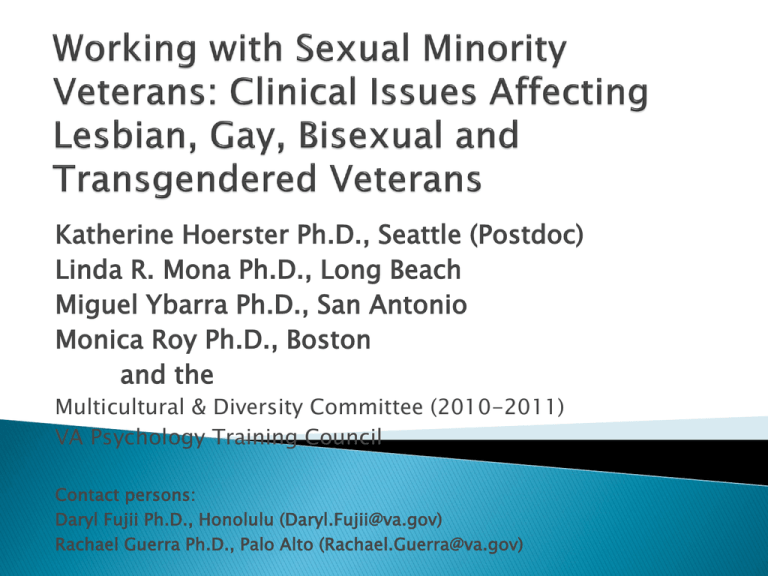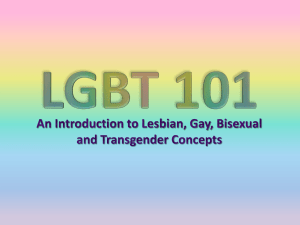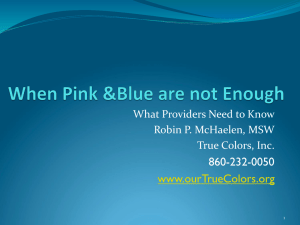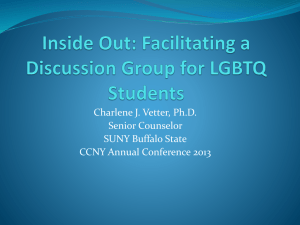
Katherine Hoerster Ph.D., Seattle (Postdoc)
Linda R. Mona Ph.D., Long Beach
Miguel Ybarra Ph.D., San Antonio
Monica Roy Ph.D., Boston
and the
Multicultural & Diversity Committee (2010-2011)
VA Psychology Training Council
Contact persons:
Daryl Fujii Ph.D., Honolulu (Daryl.Fujii@va.gov)
Rachael Guerra Ph.D., Palo Alto (Rachael.Guerra@va.gov)
Committee 2010-2011
Loretta E. Braxton Ph.D., Durham (Co-Chair)
Linda R. Mona Ph.D., Long Beach (Co-Chair)
Angelic Chaison Ph.D., Houston
Daryl Fujii Ph.D., Honolulu
Rachael Guerra Ph.D., Palo Alto
Jamylah Jackson Ph.D., North Texas
Monica Roy Ph.D., Boston
Christina Watlington Ph.D., Perry Point
Miguel Ybarra Ph.D., San Antonio
Susana Blanco Ph.D., Bedford (Postdoc)
Nancy Cha, Honolulu (Intern)
Paul Lephuoc, Houston (Intern)
Katherine Hoerster Ph.D., Long Beach (Postdoc)
The purpose of this module is to review the
empirical literature relevant to providing
clinical care to Lesbian, Gay, Bisexual, and
Transgendered (LGBT) Veterans
APA Guidelines
Definition of terms
Demographic distribution
Health and mental health disparities
Political context
Clinical implications
Transgendered Veterans
General considerations
Experiential exercises
Questions
References and resources
APA Guidelines Provide:
◦ “(1) a frame of reference for the treatment of
lesbian, gay, and bisexual clients and
◦ (2) basic information and further references in the
areas of assessment, intervention, identity,
relationships, diversity, education, training, and
research.”
◦ Outlined in 21 guidelines
E.g., “Psychologists strive to understand the effects of stigma (i.e.,
prejudice, discrimination, and violence) and its various contextual
manifestations in the lives of lesbian, gay, and bisexual people”
American Psychological Association. (2011). Guidelines for psychotherapy with lesbian,
gay, and bisexual clients. Retrieved March 28, 2011 from:
http://www.apa.org/pi/lgbt/resources/guidelines.aspx
Domains include:
◦ understanding that LGB orientations are not mental illnesses
◦ efforts to change sexual orientation have not been shown to be effective or safe
◦ recognizing how providers’ attitudes and knowledge about LGB issues may be
relevant to assessment and treatment and seek consultation or make
appropriate referrals when indicated
◦ recognizing the unique experiences of bisexual individuals
◦ distinguishing issues of sexual orientation from those of gender identity
◦ understanding the ways in which a person's LGB orientation may have an impact
on his/her family of origin and the relationship with that family of origin
◦ recognizing the challenges related to multiple and often conflicting norms,
values, and beliefs faced by LGB members of racial and ethnic minority groups
◦ considering the influences of religion and spirituality in the lives of LGB persons
◦ including LGB issues in professional education and training
American Psychological Association. (2011). Guidelines for psychotherapy with lesbian,
gay, and bisexual clients. Retrieved March 28, 2011 from:
http://www.apa.org/pi/lgbt/resources/guidelines.aspx
Gay: used to refer to a same-gender orientation, often
used for men
Lesbian: used to refer to a same-gender orientation, often
used for women
Bisexual: used to refer to a man or woman who is sexually
attracted to members of the opposite gender and to
members of the same gender
Transgendered: used to refer to individuals whose gender
identity does not match their sex
Queer: a more recent and more politically-oriented selfidentifier for gay men and women
Questioning: a term used for individuals that are seeking
more insight into their sexual orientation
Haldeman, D. C., & Buhrke, R. A. (2003). Under a rainbow flag: The diversity of sexual
orientation. In Robinson, J. D. & James L. C. (Eds.) Diversity in human interactions: The
tapestry of America (145-156). New York: Oxford University Press.
Homophobia: a term used to describe an irrational fear of
gay men and lesbians
Heterosexism: a conscious or unconscious preference for
individuals who self-describe as heterosexual
Transphobia: a term used to describe an irrational fear of
transgendered individuals
LGB: term used to refer to lesbian, gay, and bisexual
individuals
LGBT: term used to refer to lesbian, gay, bisexual, and
transgendered individuals
Haldeman, D. C., & Buhrke, R. A. (2003). Under a rainbow flag: The diversity of sexual
orientation. In Robinson, J. D. & James L. C. (Eds.) Diversity in human interactions: The
tapestry of America (145-156). New York: Oxford University Press.
Sexual Identity: refers to how an individual
interprets their own sexual and affiliative
attractions and experiences
◦ Everyone measures themselves on the constructs of
sexual identity, sexual orientation, and gender
identity
Coming out: a deliberate decision-making
process regarding whether to disclose sexual
identity and/or sexual orientation
Haldeman, D. C., & Buhrke, R. A. (2003). Under a rainbow flag: The diversity of sexual
orientation. In Robinson, J. D. & James L. C. (Eds.) Diversity in human interactions: The
tapestry of America (145-156). New York: Oxford University Press.
Several terms define relationships in purely behavioral
terms
◦ Heterosexual and homosexual
◦ Men who have sex with men (MSM); Women who have sex with
women (WSW)
MSM grew out of HIV and sexual risk literature and WSW followed
Using these terms is problematic because they ignore
the following:
◦ A continuum of sexual desire and sexual behavior (not
discrete)
◦ Broad identity that goes beyond sexual behavior and desire
◦ Relationships are more than sexual desire and behavior
◦ Broad communities and networks beyond individual
relationships
◦ Labels used by gay, lesbian, and bisexual individuals
Young, R.M., & Meyer, I. (2005). The trouble with “MSM” and “WSW”: Erasure of the
sexual-minority person in public health discourse. American Journal of Public
Health, 95, 1144-1149.
35,000 LGB Active Duty and 65,000 Guard and
Reserve
◦ 2.8% of military personnel
Rates of service higher for coupled lesbians
than for straight women; the opposite is true
for coupled gay men
Nearly one million lesbian and gay Veterans
◦ Regional concentrations
Gates, G. (2004) Gay men and lesbians in the U.S. military: Estimates from
Census 2000. Washington, DC: The Urban Institute.
Gates, G. (2004) Gay men and lesbians in the U.S. military: Estimates from
Census 2000. Washington, DC: The Urban Institute.
U.S. Department of Health and Human
Services Healthy People 2010 priority
Called for large-scale efforts to identify and
address disparities affecting LGBT populations
in:
◦ healthcare access
◦ physical and lifestyle-related illness (e.g., tobacco use,
substance use, HIV)
◦ mental health and suicide
Gay and Lesbian Medical Association and LGBT health experts. (2001). Healthy
People 2010 Companion document for lesbian, gay, bisexual, and
transgender (LGBT) health. San Francisco, CA: Gay and Lesbian Medical
Association.
2001 – 2008 Massachusetts Behavioral Risk
Factor Surveillance Survey (n=67,359)
◦ LGB more likely than straight individuals to report asthma,
activity limitation, smoking, drug use, tension or worry,
and lifetime sexual victimization
◦ Bisexual: more likely to report cardiovascular disease risk,
sadness, past-year suicidal ideation, and barriers to care
Binge drinking and lifetime intimate partner victimization more common
among bisexual women
◦ Gay men: less likely to be overweight and to obtain
prostate test
◦ Lesbian women: more likely to be obese and report
multiple risks for cardiovascular disease
Conron, K.J., et al. (2010). A population-based study of sexual orientation identity
and gender differences in adult health. American Journal of Public Health, 100,
1953-1960.
Suicide attempts
◦ Two-fold excess in lesbian, gay, and bisexual (LGB)
people
◦ Suicide attempt especially high in bisexual and gay men
12-month or lifetime anxiety or depression
◦ 1.5 x higher in LGB
Substance dependence > 12 mos.
◦ 1.5 x higher in LGB
◦ Substance dependence especially high in lesbian and
bisexual women
King, M., et al. (2008). A systematic review of mental disorder, suicide, and
deliberate self harm in lesbian, gay, and bisexual people. BMC Psychiatry, 8,
70.
High levels of discrimination reported by
lesbian, gay, and bisexual (LGB) people
◦ Associated with psychiatric distress
Distress especially high among those who did not
accept discrimination and did not discuss it with others
McLaughlin, K., et al. (2010). Responses to discrimination and psychiatric disorders among Black, Hispanic,
female, and lesbian, gay, and bisexual individuals. American Journal of Public Health, 100, 1477-1484.
Risk of PTSD and violence exposure higher
among LGB people
Roberts, A., et al. (2010). Pervasive trauma exposure among US sexual orientation minority adults and risk of
posttraumatic stress disorder. American Journal of Public Health, 100, 2433-2441.
June 27, 1969
Police raid on Stonewall Inn, a Greenwich Village
gay bar: a common occurrence at that time
Met with great resistance from patrons, followed
by several days of organized protest
Marks the beginning of the gay liberation
movement
Harlin, K. (2004) Stonewall and Beyond:Lesbian and gay culture. The
Stonewall Riot and its aftermath. New York City: Columbia University. Retrieved March
7, 2011 from
http://www.columbia.edu/cu/lweb/eresources/exhibitions/sw25/case1.html
States differ in their protections for sexual
minorities from (1) hate crimes and (2)
employment discrimination
Relationship between LGB status and
psychiatric distress is significantly stronger in
states without those protections
Institutional discrimination in the form of
state policy impacts psychiatric distress
among LGB individuals, highlighting need for
policy change
Hatzenbuehler, M., Keyes, K. & Hasin, D. (2009). State-level policies and psychiatric
morbidity in lesbian, gay, and bisexual populations. American Journal of Public
Health, 99, 2275-2281.
Consequences likely numerous during
service and following separation
◦
◦
◦
◦
access to care
chronic and infectious disease management
financial consequences of discharge conditions
empirical data are limited
◦
See Katz, K. (2010). Health hazards of “don’t ask, don’t tell”. New England Journal of Medicine, 363, 2380-1.;
and
Smith, D. (2008). Active duty military personnel presenting for care at a Gay Men’s Health Clinic. Journal of
Homosexuality, 54, 277-279.
American Psychological Association has
long opposed the policy
-American Psychological Association. (2011). Sexual orientation and military service. Retrieved March 28, 2011 from:
http://www.apa.org/pi/lgbt/resources/military.aspx
-President Barack Obama signed repeal of DADT
in December of 2010, saying "For we are not a
nation that says, 'don't ask, don’t tell.' We are a
nation that says, 'Out of many, we are one.’”
◦ Future relevant issues: Discussion Point
Will discrimination continue?
What protections will be in place for those who disclose LGB status?
Will partner benefits parallel military spousal benefits?
Will transgender Veterans be allowed to openly serve?
What action will be taken for those dishonorably discharged under
DADT?
Psychiatric morbidity related to exposure
to stressors:
◦ Prejudice, discrimination, and violence
Mood Disorders (e.g., MDD)
Anxiety Disorders (e.g., Panic attacks,
PTSD)
Substance Use
Eating Disorders
Suicidality
Kertzner, R.M., Meyer, I.H., Frost, D.M., & Stirratt, M.J. (2009). Social and psychological
well-being in lesbians, gay men, and bisexuals: The effects of race, gender, age, and
sexual identity. American Journal of Orthopsychiatry, 79(4), 500-510.
Women in same-gender relationships:
◦ less likely to have insurance
◦ less likely to have received medical care in the last
12 months
◦ significantly more likely to have unmet medical
needs than women in different-gender
relationships
Buchmueller, T. & Carpenter, C.S. (2010). Disparities in health insurance
coverage, access, and outcomes for individuals in same-sex versus differentsex relationships, 2000-2007. American Journal of Public Health, 100(3),
489-494.
While men in same-gender relationships are more
likely to have insurance, they are more likely to
report unmet medical needs, despite having a
yearly physical
This may be because medical needs differ for men
in same-gender relationships than for men in
different-gender relationships, and general
physical exams may not meet these needs
Buchmueller, T. & Carpenter, C.S. (2010). Disparities in health insurance
coverage, access, and outcomes for individuals in same-sex versus differentsex relationships, 2000-2007. American Journal of Public Health, 100(3),
489-494.
Stage theories vs. emergent continuous life process
◦ Identity confusion (Who am I?)
◦ Identity comparison (I am different)
◦ Identity tolerance (I am probably gay)
◦ Identity acceptance (I am gay)
◦ Identity pride (Gay is good; heterosexuality is bad)
◦ Identity synthesis (My gayness is one part of me)
Cass, V.C. (1979). Homosexual identity formation: A theoretical model. Journal of
Homosexuality, 4, 219-235.
Lesbian identity development
◦ Supplements information provided in traditional stage
theories; addresses the unique need of females
◦ Four phases: awareness, exploration,
deepening/commitment, and internalization/synthesis
◦ Dual identity process including personal identity and
reference group orientation
◦ Challenges prevailing ideology that political activism
and universal disclosure is equal to synthesis
McCarn, S.R., & Fassinger, R.E. (1996). Revisioning sexual minority identity
formation: A new model of lesbian identity and its implications for counseling and
research. Counseling Psychologists ,24, 508-534.
Rates of disclosure may vary across settings
Direct vs. Indirect Disclosure
◦ Revealing sexual orientation openly
Indirect Disclosure
◦ Mentioning same-sex partner by name
Studies on disclosure are not readily available for
the military culture
Disclosure is selective
Supporting factors and barriers to disclosure
Beals, K.P., & Peplau, L.A. (2006). Disclosure patterns within social networks of gay men and
lesbians. Journal of Homosexuality, 51(2), 101-120.
Comprehensively Assess:
◦ Behavioral Domain
Connectedness with LGB community
Unsafe sexual practices, interpersonal violence,
substance use
◦ Emotional & Cognitive Domain
Psychiatric symptoms may lead to difficulties in
cognitive functioning (e.g., attention & concentration)
Cognitive Behavioral Therapy (CBT)
◦ Group or individual format
◦ Offers a non-judgmental, collaborative approach
with an emphasis on empowerment for sexual
minorities
◦ Empirically supported to promote symptom reduction
◦ Teaches:
Coping strategies for internal and external
oppression; promote resilience
Skill building for emotional regulation
Attunement with internal affective states
Martell, C.R., Safren, S.A., & Prince, S.E. (2004). Cognitive behavioral therapies
with lesbian, gay, and bisexual clients. New York: The Guilford Press.
• LGB Affirmative therapy
“the integration of knowledge and awareness by the
therapist of the unique developmental cultural aspects
of LGBT individuals, the therapist’s own selfknowledge, and the translation of this knowledge and
awareness into effective and helpful therapy skills at all
stages of the therapeutic process”
Three core conditions:
◦ Therapist competence in affirmative therapy
◦ Therapist affirmation of LBGT culture
◦ Therapist openness in addressing sexual orientaion and
identity issues
Perez, R. M. (2007). The “boring” state of research and psychotherapy with lesbian, gay, bisexual,
and transgender clients: Revisiting Baron (1991). In K. J. Bieschke, R. M. Perez, & K. A. DeBord
(Eds.) Handbook of counseling and psychotherapy with lesbian, gay, bisexual, and transgender
clients (2nd ed.; pp. 399-418). Washington, DC: American Psychological Association.
Transgendered Veterans
The National Transgender Discrimination Survey (n=6,450
transgender or gender non-conforming people)
documented:
Significant discrimination, especially for ethnic and racial
minorities (i.e., Black, Latino, Asian, Native American, and
Multiracial/Other)
4x more likely than general population to have annual
income of <$10,000; 2x higher unemployment
41% had attempted suicide (1.6%, general population)
Higher rates of HIV infection, smoking, and drug and
alcohol use than the general population
19% report being denied care due to status
Grant, J.M., et al., J. (2011). Injustice at every turn: A report of the National Transgender
Discrimination Survey. Washington, D.C.: National Center for Transgender Equality
and National Gay and Lesbian Task Force.
As recent research has demonstrated that sexual orientation
disclosure is related to positive military unit cohesion, while
sexual orientation-based harassment is related to negative
military unit cohesion, it is reasonable to expect that more
veterans may be inclined to divulge that information to
mental health professionals in the VA system.
Based on this information, it appears important to consider
that disclosure of gender identity issues might also increase
within the VA system, requiring a thoughtful preparation for
the needed appropriate assessments, treatments, and other
interventions before a critical need exists.
Moradi, B. (2009). Sexual orientation disclosure, concealment, harassment, and military cohesion:
Perceptions of LGBT military veterans. Military Psychology, 21, 513-533.
10 tasks for mental health gender specialists
1.
2.
3.
4.
5.
Create a supportive environment and determine purpose of
visit: perhaps more important with this group/community as
treatment planning continues
Assessment of gender identity concerns: explore gender
identity issues, self definition, and related history
Assessment of mental stability: explore the possibility of any
co-morbid mental health issues that may impact the process
of hormonal treatment or recommendations for surgery
Education regarding treatment options and advocating for
support: Some patients/clients may be overwhelmed by their
struggle, options for treatment, and implications of hormone
treatment and reassignment surgery
Responsibility for integrated services for family members:
consider services for spouses, significant others, and other
family members
Lev, A. (2009). The ten tasks of the mental health provider: Recommendations for revision of the World Professional
Association for Transgender Health standards of care. International Journal of Transgenderism, 11, 74-99.
10 tasks for mental health gender specialists
(Cont)
6.
7.
8.
9.
10.
Determine eligibility and readiness for referral to medical
treatment: a determination that the client/patient is
psychologically, emotionally, and physically ready for
medical treatment
Completion of psychosocial assessment
Documentation letter for hormone therapy or surgery:
typically a referral letter that provides support for medical
treatment and is not an “identity document”
Provision of collaborative services: the MH professional
should be prepared to work with physicians, surgeons, and
other providers
Be available to educate or train employers, school, and
institutions: provide support and education to human
resources, managers, employers, deans, heads of
departments to address transition issues
Lev, A. (2009). The ten tasks of the mental health provider: Recommendations for revision of the World Professional
Association for Transgender Health standards of care. International Journal of Transgenderism, 11, 74-99.
•
The psychosocial assessment, as introduced in the
previous slide, includes various elements; Coolhart,
Provancer, Hager, and Wang (2008) have created a
suggested assessment to gather information regarding the
following domains:
–
–
–
–
–
–
–
Family/childhood context
Current gender expression
Sexual/relationship development
Current intimate relationship(s)
Physical and mental health
Support
Future plans and expectations
Coolhart, D., Provancher, N., Hager, A., & Wang, M., (2008). Recommending transsexual clients for gender transition: A
therapeutic tool for assessing readiness. Journal of GLBT Family Studies, 4, 301-324.
The Resolution on Transgender, Gender Identity, and Gender
Expression Non-Discrimination calls on APA to:
◦ Support legal and social recognition of transgender individuals consistent
with their gender identity and expression
◦ Support the provision of adequate and medically necessary treatment for
transgender and gender-variant people
◦ Recognize the benefit and necessity of gender transition treatments for
appropriately evaluated individuals
◦ Call on public and private insurers to cover these treatments
Furthermore, the APA Task Force on Gender Identity and
Gender Variance has submitted its full report to APA and can
be accessed at
http://www.apa.org/pi/lgbt/resources/policy/genderidentity-report.pdf
American Psychological Association. (2011). Transgender identity issues in psychology. Retrieved March 28,
2011 from: http://www.apa.org/pi/lgbt/programs/transgender/index.aspx
The American Psychological Association has
agreed to support a joint project between
the Committee on Lesbian, Gay, Bisexual,
Transgender Concerns and APA Division 44
to create new guidelines on working with
transgendered clients.
The call for general membership and
positions of leadership for this group
should be posted by the end of April 2011.
American Psychological Association. (2011). Transgender identity issues in psychology. Retrieved March 28,
2011 from: http://www.apa.org/pi/lgbt/programs/transgender/index.aspx
“Transgender individuals prefer to live
outside the traditional boundaries of gender
which may not necessitate surgical
interventions or other elements of
transition. Thus..care for transgender
patients provided for those who may
present at multiple points on this transition
continuum, including individuals who are
not seeking Genital Reassignment Surgery.”
Department of Veterans Affairs. (2008) Management of transgender veteran patients. Patient
Care Memorandum-11-046-LM. Boston, MA: VA Boston Healthcare System.
“Health care should be delivered to that veteran, based
upon that veteran’s self-identified gender, recognizing
that unique health issues are associated with some
transgender patients.”
◦ “As an example, a male-to-female transsexual should be referred
to as “she” in all contacts and documents irrespective of
appearance and/or surgical history. This is included in
documentation in the medical chart as well as on all
correspondence.”
◦ “Room assignments and access to any facilities for which gender
is normally a consideration (e.g., restrooms) should give
preference to the veteran’s self-identified gender, irrespective of
appearance and/or surgical history, in a manner that respects the
privacy needs of transgender and non-transgender patients alike.”
Department of Veterans Affairs. (2008) Management of transgender veteran patients. Patient
Care Memorandum-11-046-LM. Boston, MA: VA Boston Healthcare System.
General Considerations
Provide a safe and supportive environment
Be aware of own counter transference
Reflect client’s language
Be mindful of using heterocentric language
Discuss sexuality openly
Treat the presenting problem, not sexual
orientation
Assess:
◦ How “out” clients are to social network
◦ Social support, or lack thereof
◦ Presenting problem in the context of the individual
Assume that staff, clients, and other people
associating with the program are from diverse
sexual orientations and gender identities
◦ When completing biopsychosocial assessments ask about
sexual orientation rather than making assumptions
Do not tolerate LGBT clients being harassed or
belittled by other program clients, nor staff
◦ Address discriminatory comments in a timely and nonjudgmental manner
◦ Provide education to both program clients and staff as
needed
Lucksted, A. (2004). Raising issues: Lesbian, gay, bisexual, & transgender people
receiving services in the public mental health system. Baltimore, Maryland:
University of Maryland, Center for Mental Health Services Research, Department
of Psychiatry.
Examine one’s own information, attitudes, and
beliefs about LGBT issues and consumers
Seek out self-education opportunities and
resources
Consult with professional mental health
organizations that have committees on LGBT issues
and community organizations, especially those
with mental health components
Lucksted, A. (2004). Raising issues: Lesbian, gay, bisexual, & transgender people
receiving services in the public mental health system. Baltimore, Maryland:
University of Maryland, Center for Mental Health Services Research, Department
of Psychiatry.
Assess and improve programs operations, climate, and
quality of care regarding LGBTQ consumers
Facilitate the development of staff and organizational
competence through trainings, supervision, feedback, and
expectations
Reflect the diversity of people and lives in the program’s
physical space, including artwork, literature, flyers
Know which local mental health and human service resources
are LGBTQ-affirmative and which are not
Lucksted, A. (2004). Raising issues: Lesbian, gay, bisexual, & transgender people
receiving services in the public mental health system. Baltimore, Maryland:
University of Maryland, Center for Mental Health Services Research, Department
of Psychiatry.
Importance of intersectionality of belief
systems and identities among LGB
individuals
◦ Clinical providers are called to assess broad
array of identities in addition to LGB orientation
◦ Researchers and educators are called to be
inclusive of the potential effects of intersecting
identities in all levels of research process and
teaching methods
Race and ethnicity: consider that some
ethnic/cultural groups are more embracing of
differences in sexual orientation, while other
are less so
Disability: People with disabilities may not be
seen as sexual beings, thus sexual orientation
can be invisible
Haldeman, D. C., & Buhrke, R. A. (2003). Under a rainbow flag: The diversity of sexual
orientation. In Robinson, J. D. & James L. C. (Eds.) Diversity in human interactions: The
tapestry of America (145-156). New York: Oxford University Press.
Bisexuality: may find themselves ostracized
from the heterosexual community because of
same-gender attraction, and alienated from
the LGBT community for their other-gender
relationships
Generational Differences: individuals are
coming to terms with their sexual identity
earlier in life; individuals are living more
openly later in life; both groups are creating
new and vibrant communities
Haldeman, D. C., & Buhrke, R. A. (2003). Under a rainbow flag: The diversity of sexual
orientation. In Robinson, J. D. & James L. C. (Eds.) Diversity in human interactions: The
tapestry of America (145-156). New York: Oxford University Press.
Exercises
Considering this advice provided by the Diversity Builder’s Training
Staff, is where you work gay friendly? How true are each of these
five steps at your site? Why, or why not? Please discuss.
Is Your Business Gay-Friendly?
The Top 5 Steps in Making Your Business GLBT-Friendly
1. Hire a diverse working staff
2 Convert your company's forms to a "gay-friendly version.”
3. Offer diversity training to staff, to include "gay sensitivity
training."
4. Offer domestic partner benefits with a nondiscrimination policy.
5. Support gay-related organizations within your charitable work.
by Diversity Builder's Diversity Training Staff (http://www.diversitybuilder.com/supplier_diversity.php)
Coming Out Exercise (Modified)
◦
◦
Barry A. Schreier, Ph.D.
Purdue University
http://ccvillage.buffalo.edu/Village/WC/wsc/outlines_and_handouts/sexual_coming_out.html
Introduction
This exercise is used to assist individuals understand
loss that is often associated with Coming Out.
Preparing Stage
Step 1: Create four columns on one sheet of paper
Personalizing Stage
In the first column, participants are to write
down the names of four people who are very
special, important, and central to their
current lives. One name to one piece of
paper.
In the second column, participants are to write
down four important roles central to their
current lives. Roles can be sister, father,
student, banker, and so on. Use this prompt
only if asked.
In the third column, participants are to write
down four objects which they possess which
are very special, important, and central to
their current lives.
In the final group, participants are to write
down four activities in which they engage
which are most important to them.
Experiencing Loss Stage
Explain now that loss can come in many forms.
The first form is the form of loss that can be
predicted. As one is coming out one can often
guess that loss is going to occur and can even
say that the first set of losses will be here, here,
and here, and so on. Ask participants to now look
at their columns and pick one from each that
they could do without. Allow sufficient time for
participants to do this.
Explain that another form that loss can come in is
the form that can be predicted in that loss is
going to occur, but in which areas of life the loss
will happen can be unpredictable because how
people act on their beliefs and attitudes about
people who are Gay, Lesbian, or Bisexual is often
unpredictable. Ask participants to turn their
papers over so they cannot see what is written on
them and to pick one from each group (first line,
second role, etc.) and to scratch it off their list.
Ask participants to not turn the sheet over yet.
Explain that loss can also be completely unpredictable and
that as one feels one is safe, one can quite easily become
unsafe. That as one feels that they have sustained all the
loss they can there comes more loss. Some people get
lucky and have little to no loss and others are terribly
unfortunate and lose everything. People act on their
homophobic/biphobic attitudes and heterosexist beliefs
in a manner quite often that is blind to the devastation
they create. As you are explaining this to participants
begin to move among them and take from participants
some of their remaining roles/persons/objects. From
some take all, from some take only a few, from some take
nothing. With one individual who you might let alone,
return to them later and take everything. From those from
you take everything, take their papers, crumple them, and
haphazardly throw them aside onto the floor.
Processing Stage
Process the reactions individuals have to this
exercise and provide understanding to
participants’ experiences in terms of how
their emotional experiences easily match
the emotional experiences that people who
are Gay, Lesbian, or Bisexual often have in
their own Coming Out processes.
Questions and end.
References and Resources
American Psychological Association. (2011). Guidelines for psychotherapy with lesbian, gay, and bisexual clients.
Retrieved March 28, 2011 from: http://www.apa.org/pi/lgbt/resources/guidelines.aspx
American Psychological Association. (2011). Sexual orientation and military service. Retrieved March 28, 2011 from:
http://www.apa.org/pi/lgbt/resources/military.aspx
American Psychological Association. (2011). Transgender identity issues in psychology. Retrieved March 28, 2011 from:
http://www.apa.org/pi/lgbt/programs/transgender/index.aspx
Beals, K.P., & Peplau, L.A. (2006). Disclosure patterns within social networks of gay men and lesbians. Journal of
Homosexuality, 51(2), 101-120.
Buchmueller, T. & Carpenter, C.S. (2010). Disparities in health insurance coverage, access, and outcomes for individuals
in same-sex versus different-sex relationships, 2000-2007. American Journal of Public Health, 100(3), 489-494.
Cass, V.C. (1979). Homosexual identity formation: A theoretical model. Journal of Homosexuality, 4, 219-235.
Conron, K.J., et al. (2010). A population-based study of sexual orientation identity and gender differences in adult
health. American Journal of Public Health, 100, 1953-1960.
Coolhart, D., Provancher, N., Hager, A., & Wang, M., (2008). Recommending transsexual clients for gender transition: A
therapeutic tool for assessing readiness. Journal of GLBT Family Studies, 4, 301-324.
Department of Veterans Affairs. (2008) Management of transgender veteran patients. Patient Care Memorandum-11046-LM. Boston, MA: VA Boston Healthcare System.
Eliason, M.J., & Schope, R. (2001). Does ‘Don’t Ask Don’t Tell’ apply to health care? Lesbian, gay, and bisexual people’s
disclosure to health care providers. Journal of the Gay and Lesbian Medical Association, 5,125–134.
Gates, G. (2004) Gay men and lesbians in the U.S. military: Estimates from Census 2000. Washington, DC: The Urban
Institute.
Gay and Lesbian Medical Association and LGBT health experts. (2001). Healthy People 2010 Companion document for
lesbian, gay, bisexual, and transgender (LGBT) health. San Francisco, CA: Gay and Lesbian Medical Association.
Grant, J.M., et al., J. (2011). Injustice at every turn: A report of the National Transgender Discrimination Survey.
Washington, D.C.: National Center for Transgender Equality
and National Gay and Lesbian Task Force.
Haldeman, D. C., & Buhrke, R. A. (2003). Under a rainbow flag: The diversity of sexual orientation. In Robinson, J. D. &
James L. C. (Eds.) Diversity in human interactions: The tapestry of America (145-156). New York: Oxford University
Press.
Harlin, K. (2004) Stonewall and Beyond:Lesbian and gay culture. The Stonewall Riot and its aftermath. New York City: Columbia
University. Retrieved March 7, 2011 from http://www.columbia.edu/cu/lweb/eresources/exhibitions/sw25/case1.html
Hatzenbuehler, M., Keyes, K. & Hasin, D. (2009). State-level policies and psychiatric morbidity in lesbian, gay, and bisexual
populations. American Journal of Public Health, 99, 2275-2281.
Katz, K. (2010). Health hazards of “don’t ask, don’t tell”. New England Journal of Medicine, 363, 2380-1.
Kertzner, R.M., Meyer, I.H., Frost, D.M., & Stirratt, M.J. (2009). Social and psychological well-being in lesbians, gay men, and
bisexuals: The effects of race, gender, age, and sexual identity. American Journal of Orthopsychiatry, 79(4), 500-510.
King, M., et al. (2008). A systematic review of mental disorder, suicide, and deliberate self harm in lesbian, gay, and bisexual people.
BMC Psychiatry, 8, 70.
Lev, A. (2009). The ten tasks of the mental health provider: Recommendations for revision of the World Professional Association for
Transgender Health standards of care. International Journal of Transgenderism, 11, 74-99.
Lucksted, A. (2004). Raising issues: Lesbian, gay, bisexual, & transgender people receiving services in the public mental health
system. Baltimore, Maryland: University of Maryland, Center for Mental Health Services Research, Department of Psychiatry.
Martell, C.R., Safren, S.A., & Prince, S.E. (2004). Cognitive behavioral therapies with lesbian, gay, and bisexual clients. New York: The
Guilford Press.
McCarn, S.R., & Fassinger, R.E. (1996). Revisioning sexual minority identity formation: A new model of lesbian identity and its
implications for counseling and research. Counseling Psychologists ,24, 508-534.
McLaughlin, K., et al. (2010). Responses to discrimination and psychiatric disorders among Black, Hispanic, female, and lesbian, gay,
and bisexual individuals. American Journal of Public Health, 100, 1477-1484.
Moradi, B. (2009). Sexual orientation disclosure, concealment, harassment, and military cohesion: Perceptions of LGBT military
veterans. Military Psychology, 21, 513-533.
Pachankis, J.E., & Goldfried, M.R. (2010). Expressive writing for gay-related stress: Psychosocial benefits and mechanisms underlying
improvement. Journal of Consulting and Clinical Psychology, 78(1), 98-110.
Perez, R. M. (2007). The “boring” state of research and psychotherapy with lesbian, gay, bisexual, and transgender clients: Revisiting
Baron (1991). In K. J. Bieschke, R. M. Perez, & K. A. DeBord (Eds.) Handbook of counseling and psychotherapy with lesbian, gay,
bisexual, and transgender clients (2nd ed.; pp. 399-418). Washington, DC: American Psychological Association.
Roberts, A., et al. (2010). Pervasive trauma exposure among US sexual orientation minority adults and risk of posttraumatic stress
disorder. American Journal of Public Health, 100, 2433-2441.
Smith, D. (2008). Active duty military personnel presenting for care at a Gay Men’s Health Clinic. Journal of Homosexuality, 54, 277279.
Young, R.M., & Meyer, I. (2005). The trouble with “MSM” and “WSW”: Erasure of the sexual-minority person in public Health discourse.
American Journal of Public Health, 95, 1144-1149.
Advocacy groups have been developed
◦ Service Members Legal Defense Network:
http://www.sldn.org/ (focused on DADT)
◦ American Veterans for Equal Rights: http://aver.us/aver/
◦ Vets Do Ask Do Tell, Inc: http://www.vetsdoaskdotell.org/
(focused on promoting access to VA Care)
Legislation to end LGBT disparities
initiated
◦ H.R.3001 - Ending LGBT Health Disparities Act:
http://www.opencongress.org/bill/111-h3001/show
www.wpath.org (World Professional Association for Transgender Health, Inc.). WPATH is a
“professional organization devoted to the understanding and treatment of gender identity
disorders.” Members are spread worldwide in diverse fields (e.g. medicine, psychology, law,
social work, counseling, psychotherapy, family studies, sociology, anthropology, and sexology.
WPATH provides Referral Source lists.
www.gender.org (Gender Education and Advocacy; GEA) is a national 501(c) (3) non-profit
organization focused on the needs, issues and concerns of gender variant people in human
society. GEA seeks to “educate and advocate, not only for ourselves and others like us, but for
all human beings who suffer from gender-based oppression in all of its many forms”.
www.tavausa.org (Transgender American Veterans Association). The Transgender American
Veterans Association (TAVA) is a 501(c) 3 non-profit organization “formed to address the
growing concerns of fair and equal treatment of transgender veterans and active duty service
members…TAVA serves as an educational organization that will help the Veterans
Administration and the Department of Defense to better understand the individuals they
encounter who identify as being gender-different”.
www.tsroadmap.com (Transsexual Road Map). A private individual provides information that is
specific for transsexual transition process. It describes many of the medical issues in terms
laypeople can understand. In addition, there are links to more in-depth overviews of issues
such as surgeries and hormone therapy.










